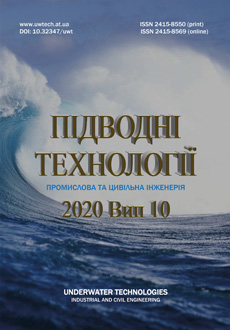Control weld geometric parameters when wet underwater welding
DOI:
https://doi.org/10.32347/uwt2020.10.1401Ключові слова:
flux-cored wire, underwater wet welding, width-to – penetration depth ratioАнотація
The aquatic environment has a significant impact on the efficiency of heat input to the base metal, significantly reducing the efficiency of the arc. As a result, in wet underwater welding, the penetration of the base metal is reduced compared to welding in the air with the same mode parameters. The purpose of the research was to determine the effectiveness of the influence of the parameters of the process of underwater wet welding with rutile-type flux-cored wire on the geometric parameters of the weld metal – its width and penetration depth of the base metal. In this case, the shape coefficient of the weld was determined - the ratio of width to penetration depth (W/P). It was found that the welding speed, wire feed speed and the amplitude of the welding torch oscillations have a significant impact on the ratio of the width to the penetration depth of the welds. The W/P ratio of welds decreases significantly with increasing welding speed without oscillation of the welding torch. So, when welding with transverse oscillations of the welding torch with an increase in the wire feed speed, it decreased from 7.14 to 3.85. And it linearly increased with increasing amplitude of the torch oscillations. It was found that the oscillation velocity, elongation of the flux-cored wire, and arc voltage have an insignificant effect on the W/P ratio.
Посилання
Michale A., 1998. Underwater wet welding became a viable option. Welding & Fab-rication, Vol.66, No 6, 12-14.
Sundarapandiyan C., Balamurugan A. and Mohan M., 2017. A Review on Under Water Welding Process. International Journal of Innovations in Engineering and Tech-nology, Vol.8, No 1, 260-265.
Maksimov S., 2017. E.O.Paton Electric Welding Institute activity in the field of underwater welding and cutting.Vol.06, 37-45.
Blackman S.A. and Woodward N.J., 2003. Hyperbaric repair and hot-tapping of deepwater pipelines and risers. International Conference of Recent Developments and Future Trends in Welding Technology (2nd), Cranfield University, 4-5 Sept. 2003.
Patel H., Patel V. and Bareth R., 2016. An Assessment over Underwater Welding Technique. International Journal of Re-search, Vol.3, No 1, 493-499.
Labanowski J., Fydrych D. and Rogalski G., 2008. Development in underwater welding.
Liu S, Rowe M., 2002. Progress in under-water wet welding: The Quintessential SMA Consumables. ASM Proceedings of the In-ternational Conference: Trends in Welding Research, Callaway Gardens Resort, Phoe-nix, Arizona, 15-19 April, 2002, 536-541.
Niu H., Tang D. and Lu T., 2012. Experi-mental Study on Structure and Property of Joints Welded with Underwater Hyperbaric Dry GMAW. Petroleum Engineering Con-struction, Vol.4.
Li K., Gao H. and Li H. 2014. Arc Be-havior of Dry Hyperbaric Gas Metal Arc Welding. Advanced Materials Research, Vol.988, 245-248.
Baune E., Bonnet C. and Liu S., 2001. Assessing metal transfer stability and spatter severity in flux cored arc welding. Science and Technology of Welding and Joining, Vol.6, No 3, 139-148.
Lucas B., 1997. The flux – cored arc process for wet welding and cutting – an assessment. TWI document, Vol.3.
Haferkamp H, Bach F.W. and Hamkens J.H., 1990. Underwater wet welding of structural steels for the off-shore sector us-ing “self-shielded” flux-cored electrodes. Welding and Cutting, Vol.5, 71-77.
Guo N., Wang M., Guo W. and Feng J., 2014. Flux-cored wire for underwater wet welding. Transactions of the China Welding Institution, Vol.35, No 5, 13-16.
##submission.downloads##
Опубліковано
Як цитувати
Номер
Розділ
Ліцензія

Ця робота ліцензується відповідно до Creative Commons Attribution 4.0 International License.
Автор(и) та Редакція згодні на те, що Редакція також матиме право:
- здійснювати необхідне оформлення Твору/Статті за результатами його редакційної обробки;
- визначати самостійно кількість видань, друк додаткових копій і тираж Твору/Статті, кількість копій окремих видань і додаткових тиражів;
- опублікування Твору/Статті в інших виданнях, пов’язаних з діяльністю Редакції

